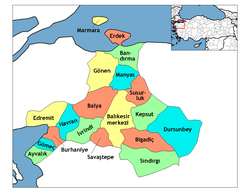Burhaniye
| Burhaniye | ||
|---|---|---|
| Town | ||
|
||
 Location of Burhaniye within Turkey. |
||
| Location of Burhaniye within Turkey. | ||
| Coordinates: 39°30′N 26°57′E / 39.500°N 26.950°ECoordinates: 39°30′N 26°57′E / 39.500°N 26.950°E | ||
| Country |
|
|
| Region | Aegean | |
| Province | Balıkesir | |
| Government | ||
| • Mayor | Necdet Uysal (AKP) | |
| Area | ||
| • District | 279.96 km2 (108.09 sq mi) | |
| Population (2012) | ||
| • Urban | 41,918 | |
| • District | 52,787 | |
| • District density | 190/km2 (490/sq mi) | |
| Time zone | EET (UTC+2) | |
| • Summer (DST) | EEST (UTC+3) | |
| Area code(s) | 266 | |
| Licence plate | 10 | |
| Website | www |
|
Burhaniye is a coastal town and district of Balıkesir Province in the Aegean region of Turkey. The district is located on the Aegean coast and is known for its olive oil.
Burhaniye has a port and a museum of archeology. A museum for the Turkish National Movement was inaugurated in 2008 under the name Burhaniye Kuvay-ı Milliye Müzesi. A biennial festival, Ören Tourism and Art Festival, is organized in July.
Burhaniye was founded as Taylıeli ('Town of Taylı') village, named after one of the Turkish beys who came to the aid of Seljuk ruler Süleyman. At the beginning of the 14th century it came under the domain of the Karasids and grew as it attracted migrants. In Ottoman times, it was also known as Kemer and attached to Edremit until 1866 and became the centre of a district named after itself. It was renamed Burhaniye after the Ottoman Prince Şehzade Burhanettin. On 29 June 1920, it was occupied by the Greek army, who set fire to the town and destroyed the town's main mosque before retreating.
Burhaniye is 4 kilometres east of the site of ancient Adramyttium, which was later moved 13 kilometres northeast to Edremit. Its history is described in the article on the modern town, which has inherited the name of the old.
Ören Beach, Burhaniye
Burhaniye Museum
Sister towns of Burhaniye
Burhaniye is twinned with:
...
Wikipedia


